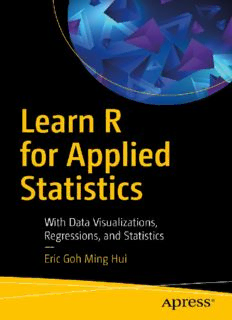
Learn R for Applied Statistics: With Data Visualizations, Regressions, and Statistics PDF
Preview Learn R for Applied Statistics: With Data Visualizations, Regressions, and Statistics
Eric Goh Ming Hui Learn R for Applied Statistics With Data Visualizations, Regressions, and Statistics Eric Goh Ming Hui Singapore, Singapore Any source code or other supplementary material referenced by the author in this book is available to readers on GitHub via the book’s product page, located at www.apress.com/978-1-4842-4199-8 . For more detailed information, please visit www.apress.com/source-code . ISBN 978-1-4842-4199-8 e-ISBN 978-1-4842-4200-1 https://doi.org/10.1007/978-1-4842-4200-1 Library of Congress Control Number: 2018965216 © Eric Goh Ming Hui 2019 Apress Standard Test Trademarked names, logos, and images may appear in this book. Rather than use a trademark symbol with every occurrence of a trademarked name, logo, or image we use the names, logos, and images only in an editorial fashion and to the benefit of the trademark owner, with no intention of infringement of the trademark. The use in this publication of trade names, trademarks, service marks, and similar terms, even if they are not identified as such, is not to be taken as an expression of opinion as to whether or not they are subject to proprietary rights. While the advice and information in this book are believed to be true and accurate at the date of publication, neither the authors nor the editors nor the publisher can accept any legal responsibility for any errors or omissions that may be made. The publisher makes no warranty, express or implied, with respect to the material contained herein. Distributed to the book trade worldwide by Springer Science+Business Media New York, 233 Spring Street, 6th Floor, New York, NY 10013. Phone 1-800- SPRINGER, fax (201) 348-4505, e-mail [email protected], or visit www.springeronline.com. Apress Media, LLC is a California LLC and the sole www.springeronline.com. Apress Media, LLC is a California LLC and the sole member (owner) is Springer Science + Business Media Finance Inc (SSBM Finance Inc). SSBM Finance Inc is a Delaware corporation. Introduction Who is this book for? This book is primarily targeted to programmers or learners who want to learn R programming for statistics. This book will cover using R programming for descriptive statistics, inferential statistics, regression analysis, and data visualizations. How is this book structured? The structure of the book is determined by following two requirements: This book is useful for beginners to learn R programming for statistics. This book is useful for experts who want to use this book as a reference. Topic Chapters Introduction to R and R programming fundamentals 1 to 3 Descriptive statistics, data visualizations, inferential statistics, and regression analysis 4 to 6 Contacting the Author More information about Eric Goh can be found at www.svbook.com . He can be reached at [email protected] . Acknowledgments Let me begin by thanking Celestin Suresh John, the Acquisition Editor and Manager, for the LinkedIn message that triggered this project. Thanks to Amrita Stanley, project manager of this book, for her professionalism. It took a team to make this book, and it is my great pleasure to acknowledge the hard work and smart work of Apress team. The following are a few names to mention: Matthew Moodie, the Development Editor; Divya Modi, the Coordinating Editor; Mary Behr for copy editing; Kannan Chakravarthy for proofreading; Irfanullah for indexing; eStudioCalamar and Freepik for image editing; Krishnan Sathyamurthy for managing the production process; and Parameswari Sitrambalam for composing. I am also thankful to Preeti Pandhu, the technical reviewer, for thoroughly reviewing this book and offering valuable feedback. Table of Contents Chapter 1: Introduction What Is R? High-Level and Low-Level Languages What Is Statistics? What Is Data Science? What Is Data Mining? Business Understanding Data Understanding Data Preparation Modeling Evaluation Deployment What Is Text Mining? Data Acquisition Text Preprocessing Modeling Evaluation/Validation Applications Natural Language Processing Three Types of Analytics Descriptive Analytics Predictive Analytics Prescriptive Analytics Big Data Volume Velocity Variety Why R? Conclusion References Chapter 2: Getting Started What Is R? The Integrated Development Environment RStudio: The IDE for R Installation of R and RStudio Writing Scripts in R and RStudio Conclusion References Chapter 3: Basic Syntax Writing in R Console Using the Code Editor Adding Comments to the Code Variables Data Types Vectors Lists Matrix Data Frame Logical Statements Loops For Loop While Loop Break and Next Keywords
Description: